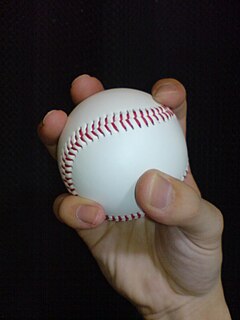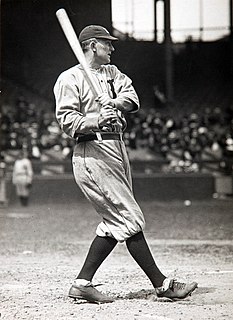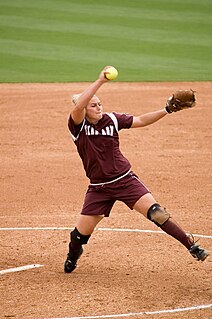
Softball is a game similar to baseball played with a larger ball on a field that has base lengths of 60 feet, a pitcher's mound that ranges from 35–43 feet away from home plate, and a home run fence that is 220–300 feet away from home plate, depending on the type of softball being played. It was invented in 1887 in Chicago, Illinois, United States as an indoor game. The game moves at a faster pace than traditional baseball due to the field being smaller and the bases and the fielders being closer to home plate. There is less time for the base runner to get to first while the opponent fields the ball; yet, the fielder has less time to field the ball while the opponent is running down to first base. The name "softball" was given to the game in 1926, because the ball used to be soft; however, in modern-day usage, the balls are hard.

A knuckleball or knuckler is a baseball pitch thrown to minimize the spin of the ball in flight, causing an erratic, unpredictable motion. The air flow over a seam of the ball causes the ball to transition from laminar to turbulent flow. This transition adds a deflecting force on the side of the baseball. This makes the pitch difficult for batters to hit, but also difficult for pitchers to control and catchers to catch; umpires are challenged as well, as the ball's irregular motion through the air makes it harder to call balls and strikes. A pitcher who throws knuckleballs is known as a knuckleballer.

In baseball, the pitcher is the player who throws the baseball from the pitcher's mound toward the catcher to begin each play, with the goal of retiring a batter, who attempts to either make contact with the pitched ball or draw a walk. In the numbering system used to record defensive plays, the pitcher is assigned the number 1. The pitcher is often considered the most important player on the defensive side of the game, and as such is situated at the right end of the defensive spectrum. There are many different types of pitchers, such as the starting pitcher, relief pitcher, middle reliever, lefty specialist, setup man, and the closer.

Catcher is a position for a baseball or softball player. When a batter takes their turn to hit, the catcher crouches behind home plate, in front of the (home) umpire, and receives the ball from the pitcher. In addition to this primary duty, the catcher is also called upon to master many other skills in order to field the position well; mainly defensively,. The role of the catcher is similar to that of the wicket-keeper in cricket, but in cricket, wicketkeepers are increasingly known for their batting abilities.

The fastball is the most common type of pitch thrown by pitchers in baseball and softball. "Power pitchers," such as former American major leaguers Nolan Ryan and Roger Clemens, rely on speed to prevent the ball from being hit, and have thrown fastballs at speeds of 95–105 miles per hour (153–169 km/h) (officially) and up to 108.1 miles per hour (174.0 km/h) (unofficially). Pitchers who throw more slowly can put movement on the ball, or throw it on the outside of home plate where batters can't easily reach it.

In baseball and softball, the curveball is a type of pitch thrown with a characteristic grip and hand movement that imparts forward spin to the ball, causing it to dive as it approaches the plate. Varieties of curveball include the 12–6 curveball and the knuckle curve. Its close relatives are the slider and the slurve. The "curve" of the ball varies from pitcher to pitcher.

A changeup is a type of pitch in baseball and fastpitch softball. The changeup is the staple off-speed pitch, usually thrown to look like a fastball but arriving much more slowly to the plate. Its reduced speed coupled with its deceptive delivery is meant to confuse the batter's timing. It is meant to be thrown the same as a fastball, but farther back in the hand, which makes it release from the hand slower while still retaining the look of a fastball. A changeup is generally thrown to be 8–15 miles per hour slower than a fastball. If thrown correctly, the changeup will confuse the batter because the human eye cannot discern that the ball is coming significantly slower until it is around 30 feet from the plate. For example, a batter swings at the ball coming at him as if it were a 90 mph fastball, but instead the ball is coming in at 75 mph—this means he will be swinging too early to hit the ball well.
In fastpitch softball, a rise ball is type of pitch that is thrown on an upward trajectory and with backspin in order to impart a rising motion. Two factors are primarily responsible for the effectiveness of the rise ball – movement and velocity. Pitchers rely on the movement of the rise ball to fool batters into swinging at pitches that appear to be in the strike zone but move up to and out of the upper part of the strike zone where they are more difficult to hit. Additionally the rise ball may be used in the lower strike zone to induce a batter to not swing at a pitch that they believe will drop out of the strike zone, but in fact travels through the zone causing the hitter to take a strike without swinging. Rise balls are high velocity pitches, generally thrown at speeds that match or are close to the pitcher’s fastball speed. At the women’s collegiate level, rise balls typically are thrown in a range of 60 to 70mph with the most dominant pitchers capable of speeds in excess of 70mph.

In baseball, a starting pitcher or starter is the first pitcher in the game for each team. A pitcher is credited with a game started if they throw the first pitch to the opponent's first batter of a game. Starting pitchers are expected to pitch for a significant portion of the game, although their ability to do this depends on many factors, including effectiveness, stamina, health, and strategy.

In baseball, a pitch is the act of throwing a baseball toward home plate to start a play. The term comes from the Knickerbocker Rules. Originally, the ball had to be literally "pitched" underhand, as with pitching horseshoes. Overhand throwing was not allowed until 1884.

An outfielder is a person playing in one of the three defensive positions in baseball or softball, farthest from the batter. These defenders are the left fielder, the center fielder, and the right fielder. As an outfielder, their duty is to catch fly balls and/ ground balls then to return them to the infield for the out or before the runner advances, if there is any runners on the bases. As an outfielder, they normally play behind the six players located in the field. By convention, each of the nine defensive positions in baseball is numbered. The outfield positions are 7, 8 and 9. These numbers are shorthand designations useful in baseball scorekeeping and are not necessarily the same as the squad numbers worn on player uniforms.

The rules of baseball differ slightly from league to league, but in general share the same basic game play.
In baseball, a sinker or sinking fastball is a type of fastball which has significant downward and horizontal movement and is known for inducing ground balls. Pitchers who use the sinker tend to rely on it heavily and do not need to change pitch speeds as much as other pitchers do because the sinking action induces weak bat contact. Other pitchers normally change pitch speeds to achieve this effect. The sinker is much more often used by right-handed than left-handed pitchers.

A batting cage is an enclosed area for baseball or softball players to practice the skill of batting.
In cricket a bowling machine is a device which enables a batsman to practice and to hone specific skills through repetition of the ball being bowled at a certain length, line and speed. It can also be used when there is no-one available to bowl, or no one of the desired style or standard.

Fastpitch softball, also known as fastpitch or fastball, is a form of softball played commonly by women and men, though coed fast-pitch leagues also exist. The International Softball Federation (ISF) is the international governing body of softball. The ISF recognizes three pitching styles: medium pitch, "modified" fast pitch, and slow pitch. Fast pitch is considered the most competitive form of softball. It is the form of softball that was played at the Olympic Games out 1996, 2000, 2004, and 2008. The fast pitch style is also used in college softball and international competition.
This is an alphabetical list of selected unofficial and specialized terms, phrases, and other jargon used in baseball, along with their definitions, including illustrative examples for many entries.












